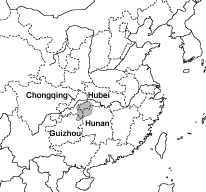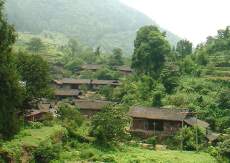

| Home > Intro | Chinese version |
Introduction to the Tujia People
Introduction
The People's Republic of China comprises 56 ethnic groups: the majority Han population and 55 ethnic minorities. 
The Origins of the Tujia
Most scholars believe that the Tujia are descendants of the ancient Ba people. The Ba Kingdom (centred on modern-day Chongqing) reached the zenith of its power between 600 BC and 400 BC but was destroyed by the Qin in 316 BC. The Ba migrated eastwards from Chongqing over a long period both before and after the collapse of their kingdom. Those living in present-day Tujia areas appear to have escaped subsequent assimilation and maintained their separate identity. After being referred to by a long succession of different names in ancient documents, they appear in historical records as the Tujia from about AD1300 onwards.
Well before this time, however, they had already developed a strongly hierarchical society, with the lowest stratum consisting of small groups of peasant farmers who were also organised into and trained as skilled fighting units. Throughout much of China's history, the imperial court sought to establish control over minority areas by recognising existing hereditary chieftainships. One of these Tujia chieftainships was that of the Peng clan, who ruled over what is now northern Xiangxi Prefecture for an incredible 818 years. Under such long-lasting dynastic successions, the Tujia in different regions were able to establish semi-independent feudal kingdoms with only nominal imperial overlordship.
The Tujia under the Ming and Qing Dynasties
The Tujia tusi chieftains reached the zenith of their power under the Ming Dynasty (1368-1644), 
The Manchus conquered China in 1644 and established the Qing Dynasty. Ever suspicious of local rulers, the Qing emperors always tried to replace Chinese officials with Manchu officials wherever they could. In the early 1700s, the Qing court finally felt secure enough to establish direct control over minority areas as well. This process, known as gaituguiliu (literally 'replace the local [ruler], return to mainstream [central rule]'), was carried out throughout south-west China gradually and, in general, peacefully. The court adopted a carrot-and-stick approach of lavish pensions for compliant chieftains, coupled with a huge show of military force on the borders of their territories.
Most of the Tujia areas returned to central control during the period 1728-1735. Whilst the Tujia peasantry probably preferred the measured rule of Qing officials to the arbitrary despotism of the Tujia chieftains whom they had replaced, many resented the attempts of the Qing court to impose Chinese culture and customs on them. With the weakening of central Qing rule, numerous large-scale uprisings occurred. The Taiping Rebellion affected the area badly, and western imperialist aggression caused great economic hardship as cheap foreign goods flooded the region, with local products being bought up at rock-bottom prices.
Recent History
Following the collapse of the Qing Dynasty, the Tujia found themselves caught between various competing warlords. More and more land was given over to the cultivation of high-earning opium at the insistence of wealthy landlords, and banditry was rife. After the founding of the People's Republic of China in 1949, Tujia areas came under Communist control, and banditry was rapidly eradicated. Subsequent land reform meant that the spectre of starvation ceased to be the ever-present companion of the peasant farmer.
The Tujia were officially recognised as one of the 55 ethnic minorities in January 1957, and a number of autonomous prefectures and counties were subsequently established.
Economy and Culture
The rugged nature of the landscape, and the remoteness of the region have meant that economic development has been slower 
As assimilation into Chinese culture increases, traditional Tujia culture is rapidly declining. Language was the first casualty, and in many areas, the massive influx of Han Chinese settlers after the gaituguiliu reforms of the early 18th century led to the swift abandonment of the Tujia language. There are now only about 70,000 Tujia speakers, that is less than 1% of the total Tujia population. Apart from Tujia New Year, which is still widely celebrated in the countryside, most Tujia customs and practices are now rarely seen, although attempts are being made to revive traditional culture, particularly dance forms such as maogusi and baishouwu.